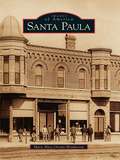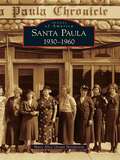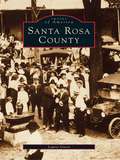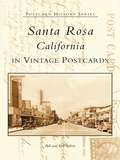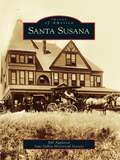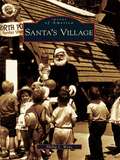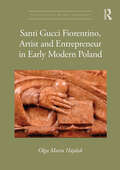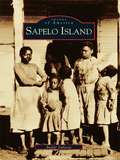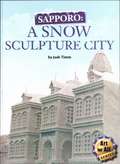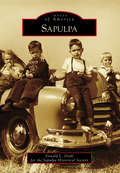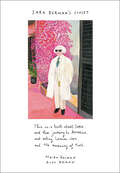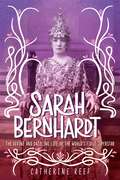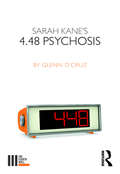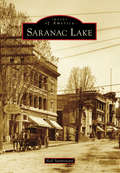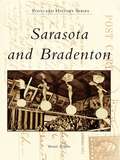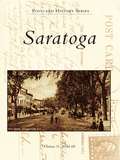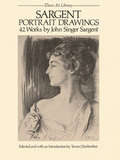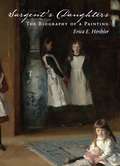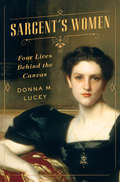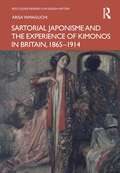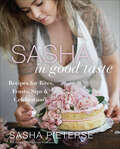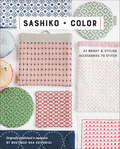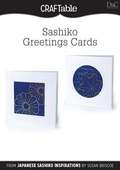- Table View
- List View
Santa Paula
by Mary Alice HendersonSanta Paula was built on the foundations of citrus cultivationand oil production. Ventura County's first irrigated 100-acreorange and lemon orchard was planted at Santa Paula in 1874, and the original 1888 harvest was so plentiful and delicious that the Limoneira Ranch Company was incorporated in 1893 and continues to thrive. Oil seeps brought wildcatters, and California's first gusher came in at Santa Paula in 1888. The town's twin notorieties through the 20th century were its designation as the "citrus capital of the world" and as the birthplace of the Union Oil Company of California (UNOCAL). Lemons and avocados remain the primary tree crops, the oil fields still produce, and the small-town character of bygone days has been preserved--Santa Paula has the largest concentration of vintage structures in the county.
Santa Paula: 1930-1960
by Mary Alice HendersonThis visual history of the 20th century's middle decades in Santa Paula illustrates how a rural city settled into its middle age. As a sequel to Images of America: Santa Paula, which covered the pioneering and settlement years of 1870 to 1930, it continues this Ventura County city's story through the Depression decade and the World War II and Korean War home front years that led up to the sixties. The time from 1930 to 1960 was prosperous for the two main industries in Santa Paula and its environs: citrus cultivation and oil production. The population increases reflected the job opportunities that these industries presented, bringing other families, businesses, and opportunities to the growing city.
Santa Rosa County
by Laurie GreenThe history of Santa Rosa County is closely associated with wood and water. Harvesting of the huge virgin pine trees that covered the area attracted industry and labor. Streams and rivers powered the machinery used to harvest the timber and also provided the means of transport. The sawmills, shipyards, turpentine stills, and related industriesmade Santa Rosa County the most industrialized county in Florida prior to the Civil War. After the war, the county rebuilt from the damage done not by raiding Yankee troops, but by retreating Confederates. The whine of the steam saw signaled the beginning of an era of great prosperity, an era that saw Milton build some of its most famous buildings and prominent businesses.
Santa Rosa, California in Vintage Postcards (Postcard History Series)
by Bob Voliva Kay VolivaFrom the first Rose Carnival in 1864, to the Great Earthquake in 1906, and the building of Highway 101, this book documents the history of Santa Rosa, illuminated in over 200 vintage postcards. Included are postcards of Luther Burbank, horticulturalist and local hero, as well as many views of Fourth Street as it changed and grew with the town.
Santa Susana
by Bill Appleton Simi Valley Historical SocietySanta Susana is one of three rural towns in Simi Valley that began at the turn of the 20th century. The town derives its name from the surrounding mountains, Sierra de Santa Susanna, and grew up alongside the railroad depot built by the Southern Pacific Company in 1903. The history of Santa Susana can be traced back to the Chumash Indian village of Ta'apu and a Spanish land grant, El Rancho Simi. The area was first surveyed by the Simi Valley Land and Water Company in 1887 for the sale of ranches. By the mid-1950s, Santa Susana had become a recognized agricultural center, noted for citrus and walnut production. Corriganville and Bottle Village are unique tourist destinations that originated near the Santa Susana Airport. In the surrounding mountains, quirky religious groups established communes away from the public with strange names and stories: Pisgah Grande, The Great Eleven Club, and WKFL Fountain of the World.
Santa's Village: Tales Of Summer Fun, Hijinx And Debauchery As Told By The People Who Worked There (Images of America)
by Phillip L. WenzSince 1959, Santa's Village in Dundee has entertained millions. The park was born of a man who as a child had no real Christmas. Glenn Holland grew up in California during the Great Depression. His parents died by the time he was 18 years old, leaving him to care for his younger sister. As a father, he tried to give his own children the type of Christmas that he only knew in his dreams. In the early 1950s, struck with inspiration, Holland sat at his kitchen table one day and started to sketch his idea for a Christmas fairyland where all the magic of the holiday would come to life: Santa's Village. Holland and general contractor Putnam Henck builtthree Santa's Villages, two in California and one in Dundee.
Santi Gucci Fiorentino, Artist and Entrepreneur in Early Modern Poland (ISSN)
by Olga Maria HajdukThe original research in this book analyzes the artistic activity of Santi Gucci (1533– c.1600), a Florentine sculptor active in Poland in the second half of the sixteenth century, and his workshop.Chapters examine the organization of the artistic workshop (sculpting and masonry) and the model of the artist’s functioning as an entrepreneur in Renaissance Poland, using Santi Gucci’s activity as an example. Gucci shaped the image of Polish sculpture in the sixteenth century for more than 50 years, even though his work has not yet been fully examined. The author sets Gucci’s emigration within the context of the cultural exchanges between Italy and Poland that contributed to the development of the Polish Renaissance.The book will be of interest to scholars working in art history, Renaissance studies, architectural history and economic history.
Sapelo Island: People And Place On A Georgia Sea Island (Images of America)
by Buddy SullivanThe barrier islands of the south Atlantic coastline have for years held a deep attraction for all who have come into contact with them. Few, however, can compare with the mystique of Sapelo Island, Georgia. This unique semitropical paradise evokes a time long forgotten, when antebellum cotton plantations dominated her landscape, all worked by hundreds of black slaves, the descendants of whom have lived in quiet solitude on the island for generations. For more than 50 years of the twentieth century, two millionaires held sway on Sapelo, and it is their story, interwoven with that of the island's residents, that unfolds within the pages of this book. Almost 200 photographs provide testimony to the dynamic forces and energies implanted upon Sapelo by two men, Howard E. Coffin, a Detroit automotive pioneer, and Richard J. Reynolds Jr., heir to a huge North Carolina tobacco fortune. Beginning with a photographic essay about Sapelo's antebellum plantation owner, Thomas Spalding, Sapelo Island moves into the primary focus of the story, the years from 1912 to 1964, an era of grandeur that has left a rich photographic legacy.
Sapporo: A Snow Sculpture City (Fountas & Pinnell LLI Gold #Level Q)
by Josh Timm<p>Freezing Fun <p>In northern Japan, the month of February is bleak--freezing, dark, and piled with snow. But one city has figured out a way to turn a dreary month into something magical. Every year, the city of Sapporo hosts a snow festival, which turns the city into a fantasyland, filled with huge snow sculptures, delicate ice statues, and warm friendships. <p> <p>Text Elements: <li>Genre: Nonfiction, Expository <li>Text Structures: Main: Categorical, Embedded: Temporal Sequence, Cause/Effect, Description <li>Text Features: table of contents, headings, photos, captions, labels, sidebars</li> </p>
Sapulpa (Images of America)
by Donald L. Diehl for the Sapulpa Historical SocietySapulpa is named after a young Creek Indian who came to the area around 1840 and opened a trading post near Pole Cat Creek. Sapulpa’s arrival in Indian Territory was independent of the famed “Trail of Tears,” a term used for the federal government’s forced removal of Creek (Muskogee) and other tribes from their southern homelands in the 1830s. The area that would become the Creek Nation is a small part of the land acquired by the United States after the Louisiana Purchase in 1803. At one time, Spain, England, and France each laid claim to Oklahoma. Trails, rails, and oil; bricks, clay, and glass; and streetcars, highways, and automobiles are all parts of the historic community of Sapulpa. The diverse people who came to the area—Indians, cowboys, railroaders, settlers, loggers, farmers, wildcatters, oilmen, businessmen, manufacturers, workers, and dreamers—recorded the town’s story, as captured in photographs, beginning more than a century ago. Sapulpa was and remains a crossroads in more ways than one.
Sara Berman's Closet
by Maira Kalman Alex KalmanMaira Kalman, the author of the bestsellers The Principles of Uncertainty and The Elements of Style, and Alex Kalman, the designer, curator, writer, and founder of Mmuseumm, combine their talents in this captivating family memoir, a creative blend of narrative and striking visuals that is a paean to an exceptional woman and a celebration of individuality, personal expression, and the art of living authentically.In the early 1950s, Jewish émigré Sara Berman arrived in the Bronx with her husband and two young daughters When the children were grown, she and her husband returned to Israel, but Sara did not stay for long. In the late 1960s, at age sixty, she left her husband after thirty-eight years of marriage. One night, she packed a single suitcase and returned alone to New York City, moving intoa studio apartment in Greenwich Village near her family. In her new home, Sara began discovering new things and establishing new rituals, from watching Jeopardy each night at 7:00 to eating pizza at the Museum of Modern Art’s cafeteria every Wednesday. She also began discarding the unnecessary, according to the Kalmans: "in a burst of personal expression, she decided to wear only white." Sara kept her belongings in an extraordinarily clean and organized closet. Filled with elegant, minimalist, heavily starched, impeccably pressed and folded all-white clothing, including socks and undergarments, as well as carefully selected objects—from a potato grater to her signature perfume, Chanel No.19—the space was sublime. Upon her death in 2004, her family decided to preserve its pristine contents, hoping to find a way to exhibit them one day.In 2015, the Mmuseumm, a new type of museum located in a series of unexpected locations founded and curated by Sara’s grandson, Alex Kalman, recreated the space in a popular exhibit—Sara Berman's Closet—in Tribeca. The installation eventually moved to the Metropolitan Museum of Art, and in spring 2019, will become an outdoor monument to independence at the National Museum of American Jewish History on Independence Mall in Philadelphia.Inspired by the exhibit, this spectacular illustrated memoir, packed with family photographs, exclusive images, and Maira Kalman's distinctive paintings, is an ode to Sara’s life, freedom, and re-invention. Sara Berman’s Closet is an indelible portrait of the human experience—overcoming hardship, taking risks, experiencing joy, enduring loss. It is also a reminder of the significance of the seemingly insignificant moments in our lives—the moments we take for granted that may turn out to be the sweetest. Filled with a daughter and grandson’s wry and touching observations conveyed in Maira’s signature script, Sara Berman’s Closest is a beautiful, loving tribute to one woman’s indomitable spirit.
Sarah Bernhardt: The Divine and Dazzling Life of the World's First Superstar
by Catherine ReefA tantalizing biography for teens on Sarah Bernhardt, the first international celebrity and one of the greatest actors of all time, who lived a highly unconventional, utterly fascinating life. Illustrated with more than sixty-five photos of Bernhardt on stage, in film, and in real life. Sarah Bernhardt was a French stage actor who became a global superstar in the late nineteenth century—the Lady Gaga of her day—and is still considered to be one of the greatest performers of all time. This fast-paced account of her life, filled with provocative detail, brilliantly follows the transformation of a girl of humble origins, born to a courtesan, into a fabulously talented, wealthy, and beloved icon. Not only was her acting trajectory remarkable, but her personal life was filled with jaw-dropping exploits, and she was extravagantly eccentric, living with a series of exotic animals and sleeping in a coffin. She grew to be deeply admired around the world, despite her unabashed and public promiscuity at a time when convention was king; she slept with each of her leading men and proudly raised a son without a husband. A fascinating and fast-paced deep dive into the world of the divine Sarah. Illustrated with more than sixty-five photos of Bernhardt on stage, in film, and in real life.
Sarah Kane's 4.48 Psychosis (The Fourth Wall)
by Glenn D'Cruz"Everything passes/Everything perishes/Everything palls" – 4.48 Psychosis <P><P> How on earth do you award aesthetic points to a 75-minute suicide note? The question comes from a review of 4.48 Psychosis’ inaugural production, the year after Sarah Kane took her own life, but this book explores the ways in which it misses the point. Kane’s final play is much more than a bizarre farewell to mortality. It’s a work best understood by approaching it first and foremost as theatre – as a singular component in a theatrical assemblage of bodies, voices, light and energy. The play finds an unexpectedly close fit in the established traditions of modern drama and the practices of postdramatic theatre. <P><P> Glenn D’Cruz explores this theatrical angle through a number of exemplary professional and student productions with a focus on the staging of the play by the Belarus Free Theatre (2005) and Melbourne’s Red Stitch Theatre (2007).
Sarah Style
by Sarah RichardsonIn the flawless style of Deborah Needleman's Domino comes the interior design book of the decade, from HGTV star, virtual sensation, and Canadian design queen Sarah Richardson.Ever wondered how to transform your laundry room from drab to fab? Your kitchen from prison to paradise? Your bedroom from boring to beautiful? Now you can, in this comprehensive interior design tome by design maven extraordinaire Sarah Richardson. Within these beautiful, full-color pages and photographs, Sarah walks you through each room in your home, from the master bedroom to the kids' rooms, to the kitchen, the bathroom, and everywhere in between, showing you how to turn a house into a home--Sarah style. Featuring full-page design spreads with stunning attention to detail, Sarah Style is a cache of creative, unique ideas for transforming your living spaces. You can make your dream home a reality, and the inspiration--and complete know-how--is right here in this premier source for all things interior design!
Saranac Lake
by Neil SurprenantThe first settlers came to Saranac Lake beginning in 1819 to make a living from the forests of the Adirondacks. In the 1870s, wealthy city dwellers discovered the hunting, fishing, boating, and hiking available in these beautiful mountains, and Saranac Lake became the hub for local tourism. By 1900, Dr. Edward Livingston Trudeau had established the fresh-air cure for tuberculosis, and Saranac Lake became America's "Pioneer Health Resort." A culture of excellent medical facilities, an active arts scene, and a great library and educational system combined with traditional Adirondack values to make Saranac Lake "the Little City of the Adirondacks," a special place to everyone who got to know it. Later in the 20th century, the focus shifted from health to scientific research, education, state government offices, and the more middle class tourist industry of the post-World War II era. This designated All-America City has retained that special character.
Sarasota and Bradenton
by Bonnie WilponFrom the 1890s through the 1920s, the postcard was an extraordinarily popular means of communication, and many of the postcards produced during this "golden age" can today be considered works of art. Postcard photographers traveled the length and breadth of the nation snapping photographs of busy street scenes, documenting local landmarks, andassembling crowds of local children only too happy to pose for a picture. These images, printed as postcards and sold in general stores across thecountry, survive as telling reminders of an important era in America's history. This fascinating new history of Sarasota and Bradenton, Florida,showcases more than two hundred of the best postcards available.
Saratoga (Postcard History Series)
by Thomas N. Wood IIIBecause of its strategic location, throughout the years Saratoga has been the site of numerous warring parties and battles, transportation links, industrial development, agricultural pursuits, recreational activities, and residential growth. Before it became a part of Saratoga County in 1791, the town of Saratoga belonged to Albany County and was much larger than its current size. Although rural in character, the town is composed of a number of hamlets and villages that have played an important part in Saratoga's development.
Sargent Portrait Drawings: 42 Works
by John Singer SargentPortraiture is a demanding art requiring the artist to capture a likeness and render it revealing some hint of the personality behind the image. A two-pronged task, it requires great technical skill and an intuitive eye. In both these respects, John Singer Sargent stands out as a portrait artist of major stature.Born in 1856 in Florence of American parents, Sargent showed artistic aptitude at an early age and was enrolled at the Academia delle Belle Arti in that city. Later he studied with Parisian artist Carolus Duran, acquiring the loose, painterly style for which he is renowned. International acclaim as a portrait artist came early in his life and followed him throughout his career.Sargent's portraits done in oil are well known; they appear in major museums throughout the world. A lesser-known but no less respected aspect of his oeuvre, his portrait drawings are the focus of this collection. Included here are early works in pencil and pastels, and later renderings in charcoal, a medium Sargent favored after 1910. They have been selected from both public and private collections by art historian Trevor J. Fairbrother and attest to Sargent's technical skill, versatility, and dexterity in three different mediums.In addition, these works reveal Sargent's ability to treat a diverse group of subjects; he handles the languorous beauties of the Edwardian age, members of the aristocracy, and the great literary and artistic figures of his day with equal virtuosity, capturing their characteristic mood and style. This collection includes portraits of Lord and Lady Spencer, Henry James, William Butler Yeats, Vaslav Nijimsky, Tamara Karsavina, Dame Ethel Smyth, and Jascha Heifetz.Artists, students, historians, and lovers of portraiture will appreciate this selection of drawings by Sargent. Anyone interested in trying his hand at portraiture will find this volume both instructional and inspirational.
Sargent's Daughters
by John Singer Sargent Erica E. HirshlerJohn Singer Sargent's renowned portrait "The Daughters of Edward Darley Boit" is examined in an aesthetic, philosophical, and personal tour de force that has been called "thoroughly absorbing" (New York Times Book Review); "brilliant and insightful"?(Wall Street Journal); "an attractive, well-illustrated scholarly book, further enlivened by the author's warm and friendly tone" (Times Literary Supplement); "a uniquely crafted history" (The Magazine Antiques); "a brilliant work of criticism, without a word of jargon in it" (Maine Antique Digest); "sensitive and penetrating" (Choice); and "a meticulously researched account of [the Boits'] milieu, their eccentric lifestyle, its unintended effects on their daughters, and of the creation of the enchanting masterwork" (Cape Cod Times).
Sargent's Daughters
by John Singer Sargent Erica E. HirshlerOne of the most celebrated painters of his day, John Singer Sargent defines for many the style, optimism and opulence of turn-of-the-century America. Among his renowned portraits, "The Daughters of Edward Darley Boit" stands alongside "Madame X" and "Lady Agnew of Lochnaw" as one of Sargent's immortal images. This painting depicts four young sisters in the spacious foyer of the family's Paris apartment, strangely dispersed across the murky tones and depths of the square canvas, as though unrelated to one another, unsettled and unsettling to the eye. "The Daughters" both affirms and defies convention, flouting the boundaries between portrait and genre scene, formal composition and quick sketch or snapshot. Unveiled at the Paris Salon of 1883, it predated by just two years the scandal of "Madame X" and was itself characterized by one critic as "four corners and a void"; but Henry James came closer to the mark when he described the painter as a "knock-down insolence of talent," for few of Sargent's works embody the epithet as well as "The Daughters of Edward Darley Boit." Drawing on numerous unpublished archival documents, scholar Erica E. Hirshler excavates all facets of this iconic canvas, discussing not only its significance as a work of art but also the figures and events involved in its making, its importance for Sargent's career, its place in the tradition of artistic patronage and the myriad factors that have contributed to its lasting popularity and relevance. The result is an aesthetic, philosophical and personal tour de force that will change the way you look at Sargent's work, and that both illuminates an iconic painting and reaffirms its pungent magnetism.
Sargent's Women: Four Lives Behind The Canvas
by Donna M. LuceyA New York Times Book Review Editors’ Choice Selection “[Lucey] delivers the goods, disclosing the unhappy or colorful lives that Sargent sometimes hinted at but didn’t spell out.”—Boston Globe In this seductive, multilayered biography, based on original letters and diaries, Donna M. Lucey illuminates four extraordinary women painted by the iconic high-society portraitist John Singer Sargent. With uncanny intuition, Sargent hinted at the mysteries and passions that unfolded in his subjects’ lives. These women inhabited a rarefied world of wealth and strict conventions—yet all of them did something unexpected, something shocking, to upend society’s rules.
Sartorial Japonisme and the Experience of Kimonos in Britain, 1865-1914 (Routledge Research in Design History)
by Arisa YamaguchiUsing interdisciplinary research and critical analysis, this book examines experiences through (or with) kimonos in Britain during the late Victorian and Edwardian periods. Bringing new perspectives to challenge the existing model of ‘Japonisme in fashion’ and introducing overlooked contacts between kimonos and people, this book explores not only fine arts and department stores but also a variety of theatres and cheap postcards. Putting a particular focus on the responses and reactions elicited by kimonos in visual, textual and material forms, this book initiates an entirely new discussion on the British adoption of Japanese kimonos beyond the monolithic view of the relationship between the East and West. This book will be of interest to scholars working in fashion studies, British studies, Japanese studies, design history and art history.
Sasha in Good Taste: Recipes for Bites, Feasts, Sips & Celebrations
by Sasha PieterseThe star of the hit TV series Pretty Little Liars shares an inspiring and delectable guide to cooking, baking, DIY, and embracing the joy of entertaining.For as long as she can remember, Sasha Pieterse has had a passion for food and entertaining. Now she shares her flair for the festive with a collection of her favorite recipes, décor ideas, and tips and tricks for throwing the ultimate party for any occasion. Covering every aspect of party planning, from budgeting to creating a menu to fun DIY projects that help set the mood, Sasha in Good Taste includes:SAVORY RECIPES: Burrata Meatballs, Stuffed Jalapeños, Whipped Ricotta Cheese Toast, yum . . .SWEET BITES: Whiskey Cupcakes, Adult Cookies and Milk, Churro Bowls, oh my!CURATED COCKTAILS: With "polite," "sassy," and nonalcoholic optionsPARTY IDEAS: From Cigar Bars to Paint Parties to FriendsgivingAnd more!
Sashiko + Color: 23 Bright & Stylish Accessories to Stitch
by Boutique-Sha EditorialStitch sweet and colorful Sashiko projects! Bring a pop of color to traditional Sashiko stitching! Make 23 different projects with your choice of colorful thread and project surface to create something unique to you. Projects include totes, bags, purses, towels, table decor, picnic cloths, and more! Fill your home with charming Sashiko pieces or give them as gifts with a personal touch. Originally published in Japan from Boutique-sha Editorial, each project values the traditional art of Sashiko while bringing a brand new twist to the designs. Embroidery enthusiasts explore stitching Sashiko and enjoy 18 stitch patterns that can be applied to any project Expand upon traditional indigo and white Sashiko with bursts of color and working with different threads and background surfaces Includes beautiful Japanese photography and craftsmanship
